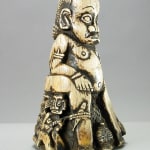Grasslands Bone Sculpture of a Seated Oba, 20th Century CE
Bone
7.375 x 11.75
PF.2861 (LSO)
Further images
This striking piece is a bone carving of a king, rendered by a carver pertaining to the Cameroons area. It is certainly a remarkable object. It represents a seated, corpulent,...
This striking piece is a bone carving of a king, rendered by a carver pertaining to the Cameroons area. It is certainly a remarkable object. It represents a seated, corpulent, older man, with a high brow, a broad nose, a short trunk and his left hand resting on his knee. The eyes are solid centres ringed by an oval, and framed by thin, high brows. The lower jar and mouth are prognathic. The detailing is remarkable, with cross-hatched headwear, armlets, a cup clenched in the left hand, a bracelet on the right wrist and tiny details such as the nipples carefully defined. He is seated upon a highly ornate circular throne (a pattern that is well-known in the Grasslands area) that is fully decorated with floral scrollwork designs. On either side there is a tiny, kneeling male (?), at least one of which is seemingly tied to the throne and the king’s legs by ropes. These have been interpreted to be prisoners. There is a flask of some sort on the floor between his feet.
Cameroon contains four main areas – the Grasslands, the Nigerian Border Region, the Forest Zone and the North – that can usually be differentiated on the basis of their artistic output. The current piece, however, presents certain problems in that it appears to be unique and thus impossible to assign with certainty. It has been linked tentatively to the Grasslands region on the basis of the detailed latticework on the stool, but this is subject to review. The main tribes in this area are the Bamileke, the Tikar and the Bamun, which are distinct groups while sharing considerable similarities in terms of social structure. Each is further subdivided – the Bamileke are comprised of many kingdoms including the Batcham, the Bafang and the Bafoussan – into kingdoms of greater or lesser power and, for our purposes, artistic note. All have powerful king figures, and it is likely that is what being portrayed here. The Tikar are noted for their tendency to produce short, fat, somewhat distorted figures with infantilistic faces, and this is thus unlikely to pertain to the group. The facial features are much more refined than most figures, and as the Bamileke produce the greatest proportion of fine-featured figures, this is the most likely source for the piece.
Whatever the origin, this is a piece that is all about power. The authority of the figure is unmistakable. The material is probably elephant bone, usually reserved for elite pieces. This is an important and unusual object.
Cameroon contains four main areas – the Grasslands, the Nigerian Border Region, the Forest Zone and the North – that can usually be differentiated on the basis of their artistic output. The current piece, however, presents certain problems in that it appears to be unique and thus impossible to assign with certainty. It has been linked tentatively to the Grasslands region on the basis of the detailed latticework on the stool, but this is subject to review. The main tribes in this area are the Bamileke, the Tikar and the Bamun, which are distinct groups while sharing considerable similarities in terms of social structure. Each is further subdivided – the Bamileke are comprised of many kingdoms including the Batcham, the Bafang and the Bafoussan – into kingdoms of greater or lesser power and, for our purposes, artistic note. All have powerful king figures, and it is likely that is what being portrayed here. The Tikar are noted for their tendency to produce short, fat, somewhat distorted figures with infantilistic faces, and this is thus unlikely to pertain to the group. The facial features are much more refined than most figures, and as the Bamileke produce the greatest proportion of fine-featured figures, this is the most likely source for the piece.
Whatever the origin, this is a piece that is all about power. The authority of the figure is unmistakable. The material is probably elephant bone, usually reserved for elite pieces. This is an important and unusual object.







